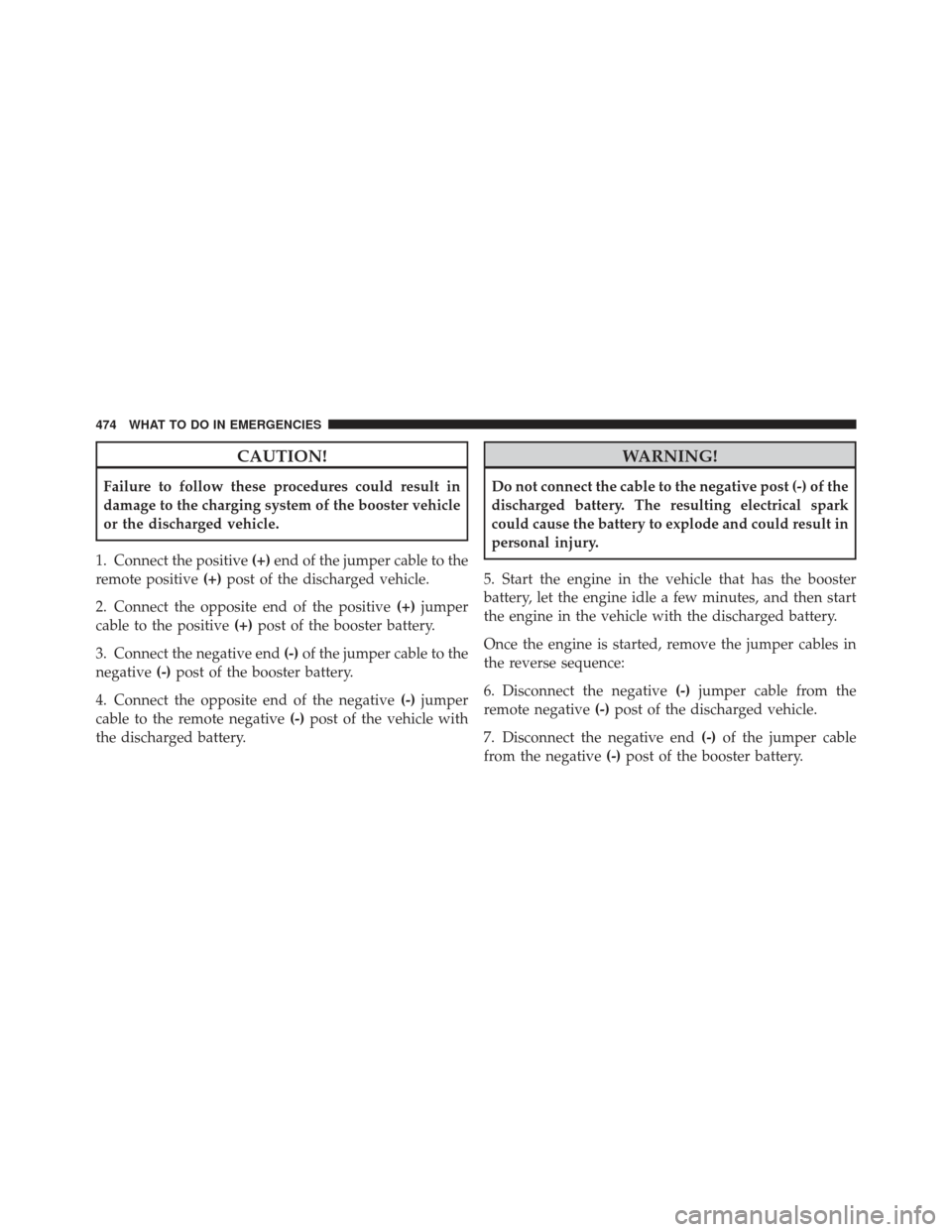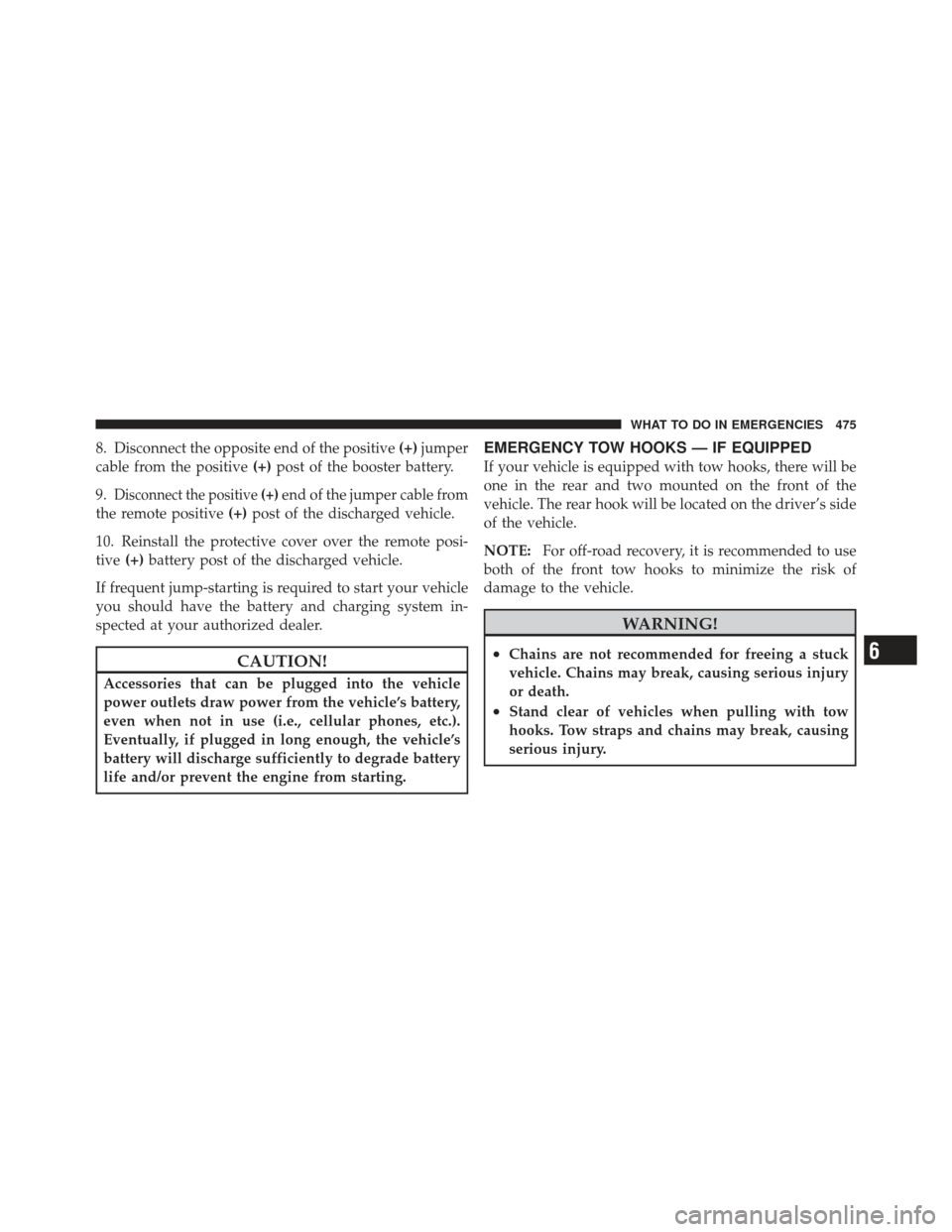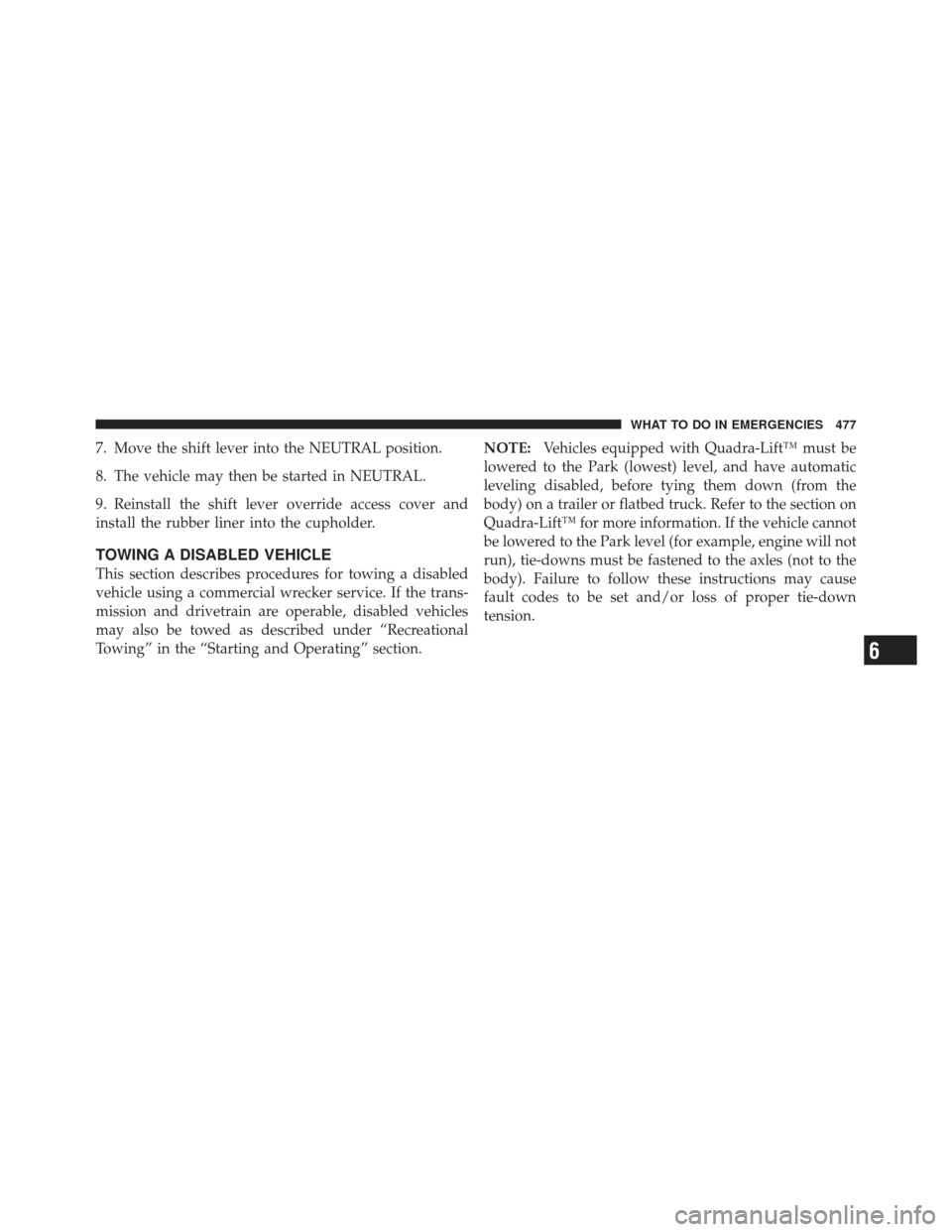Page 466 of 587
WARNING! (Continued)
•Being under a jacked-up vehicle is dangerous. The
vehicle could slip off the jack and fall on you. You
could be crushed. Never put any part of your body
under a vehicle that is on a jack.
•Never start or run the engine while the vehicle is
on a jack. If you need to get under a raised vehicle,
take it to a service center where it can be raised on
a lift.
•The jack is designed to be used as a tool for
changing tires only. The jack should not be used to
lift the vehicle for service purposes. The vehicle
should be jacked on a firm level surface only.
Avoid ice or slippery areas.
Jack Location
The scissor-type jack and tire changing tools are located
in rear cargo area, below the load floor.
Spare Tire Stowage
The spare tire is stowed under the load floor in the rear
cargo area and is secured to the body with a special wing
nut.
Jack Storage Location
464 WHAT TO DO IN EMERGENCIES
Page 468 of 587
Jacking Instructions
WARNING!
Carefully follow these tire changing warnings to
help prevent personal injury or damage to your
vehicle:
•Always park on a firm, level surface as far from
the edge of the roadway as possible before raising
the vehicle.
•Turn on the Hazard Warning flasher.
•Block the wheel diagonally opposite the wheel to
be raised.
•Set the parking brake firmly and set an automatic
transmission in PARK.
•Never start or run the engine with the vehicle on a
jack.(Continued)
WARNING! (Continued)
•Do not let anyone sit in the vehicle when it is on a
jack.
•Do not get under the vehicle when it is on a jack.
•Only use the jack in the positions indicated and
for lifting this vehicle during a tire change.
•If working on or near a roadway, be extremely
careful of motor traffic.
•To assure that spare tires, flat or inflated, are
securely stowed, spares must be stowed with the
valve stem facing the ground.
Jack Warning Label
466 WHAT TO DO IN EMERGENCIES
Page 476 of 587

CAUTION!
Failure to follow these procedures could result in
damage to the charging system of the booster vehicle
or the discharged vehicle.
1. Connect the positive (+)end of the jumper cable to the
remote positive (+)post of the discharged vehicle.
2. Connect the opposite end of the positive (+)jumper
cable to the positive (+)post of the booster battery.
3. Connect the negative end (-)of the jumper cable to the
negative (-)post of the booster battery.
4. Connect the opposite end of the negative (-)jumper
cable to the remote negative (-)post of the vehicle with
the discharged battery.
WARNING!
Do not connect the cable to the negative post (-) of the
discharged battery. The resulting electrical spark
could cause the battery to explode and could result in
personal injury.
5. Start the engine in the vehicle that has the booster
battery, let the engine idle a few minutes, and then start
the engine in the vehicle with the discharged battery.
Once the engine is started, remove the jumper cables in
the reverse sequence:
6. Disconnect the negative (-)jumper cable from the
remote negative (-)post of the discharged vehicle.
7. Disconnect the negative end (-)of the jumper cable
from the negative (-)post of the booster battery.
474 WHAT TO DO IN EMERGENCIES
Page 477 of 587

8. Disconnect the opposite end of the positive(+)jumper
cable from the positive (+)post of the booster battery.
9.
Disconnect the positive (+)end of the jumper cable from
the remote positive (+)post of the discharged vehicle.
10. Reinstall the protective cover over the remote posi-
tive (+)battery post of the discharged vehicle.
If frequent jump-starting is required to start your vehicle
you should have the battery and charging system in-
spected at your authorized dealer.
CAUTION!
Accessories that can be plugged into the vehicle
power outlets draw power from the vehicle’s battery,
even when not in use (i.e., cellular phones, etc.).
Eventually, if plugged in long enough, the vehicle’s
battery will discharge sufficiently to degrade battery
life and/or prevent the engine from starting.
EMERGENCY TOW HOOKS — IF EQUIPPED
If your vehicle is equipped with tow hooks, there will be
one in the rear and two mounted on the front of the
vehicle. The rear hook will be located on the driver’s side
of the vehicle.
NOTE: For off-road recovery, it is recommended to use
both of the front tow hooks to minimize the risk of
damage to the vehicle.
WARNING!
•Chains are not recommended for freeing a stuck
vehicle. Chains may break, causing serious injury
or death.
•Stand clear of vehicles when pulling with tow
hooks. Tow straps and chains may break, causing
serious injury.
6
WHAT TO DO IN EMERGENCIES 475
Page 478 of 587
CAUTION!
Tow hooks are for emergency use only, to rescue a
vehicle stranded off road. Do not use tow hooks for
tow truck hookup or highway towing. You could
damage your vehicle.
SHIFT LEVER OVERRIDE
If a malfunction occurs and the shift lever cannot be
moved out of the PARK position, you can use the
following procedure to temporarily move the shift lever:
1. Firmly set the parking brake.
2. Turn the ignition switch to the ON/RUN position
without starting the engine.
3. Remove the rubber liner from the cupholder (located
next to the shifter on the center console).4. Using a screwdriver or similar tool, carefully remove
the shift lever override access cover, located on the
bottom of the cupholder.
5. Press and maintain firm pressure on the brake pedal.
6. Using the screwdriver or similar tool, press and hold
the shift lock lever down.
Shift Lever Override Access Cover
476 WHAT TO DO IN EMERGENCIES
Page 479 of 587

7. Move the shift lever into the NEUTRAL position.
8. The vehicle may then be started in NEUTRAL.
9. Reinstall the shift lever override access cover and
install the rubber liner into the cupholder.
TOWING A DISABLED VEHICLE
This section describes procedures for towing a disabled
vehicle using a commercial wrecker service. If the trans-
mission and drivetrain are operable, disabled vehicles
may also be towed as described under “Recreational
Towing” in the “Starting and Operating” section.NOTE:
Vehicles equipped with Quadra-Lift™ must be
lowered to the Park (lowest) level, and have automatic
leveling disabled, before tying them down (from the
body) on a trailer or flatbed truck. Refer to the section on
Quadra-Lift™ for more information. If the vehicle cannot
be lowered to the Park level (for example, engine will not
run), tie-downs must be fastened to the axles (not to the
body). Failure to follow these instructions may cause
fault codes to be set and/or loss of proper tie-down
tension.
6
WHAT TO DO IN EMERGENCIES 477
Page 483 of 587
MAINTAINING YOUR VEHICLE
CONTENTS
�Engine Compartment – 3.6L .............. 483
� Engine Compartment – 5.7L .............. 484
� Onboard Diagnostic System – OBD II ....... 485
▫ Loose Fuel Filler Cap Message ........... 485
� Emissions Inspection And Maintenance
Programs ............................ 486
� Replacement Parts ..................... 487
� Dealer Service ........................ 488
� Maintenance Procedures ................. 488
▫ Engine Oil ......................... 489 ▫
Engine Oil Filter ..................... 492
▫ Engine Air Cleaner Filter ............... 492
▫ Maintenance-Free Battery .............. 493
▫ Air Conditioner Maintenance ............ 495
▫ Body Lubrication .................... 496
▫ Windshield Wiper Blades ............... 496
▫ Adding Washer Fluid ................. 498
▫ Exhaust System ..................... 499
▫ Cooling System ..................... 502
7
Page 484 of 587

▫Brake System ....................... 507
▫ Front/Rear Axle Fluid ................. 509
▫ Transfer Case ....................... 510
▫ Automatic Transmission ............... 511
▫ Appearance Care And Protection From
Corrosion .......................... 515
� Fuses .............................. 520
▫ Totally Integrated Power Module ......... 520
� Vehicle Storage ....................... 525
� Replacement Bulbs .................... 526
� Bulb Replacement ..................... 527
▫ High Intensity Discharge Headlamps (HID) –
If Equipped ........................ 527 ▫
Halogen Headlamps – If Equipped ........ 527
▫ Front Turn Signal .................... 528
▫ Front Fog Lamps .................... 528
▫ Rear Tail, Stop, Turn Signal, And Backup
Lamps ............................ 530
▫ Rear Liftgate Mounted Tail Lamp ......... 531
▫ Center High-Mounted Stop Lamp
(CHMSL) .......................... 532
▫ Rear License Lamp ................... 532
� Fluid Capacities ...................... 533
� Fluids, Lubricants, And Genuine Parts ....... 534
▫ Engine ............................ 534
▫ Chassis ........................... 535
482 MAINTAINING YOUR VEHICLE